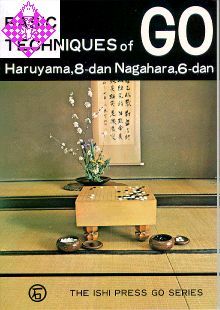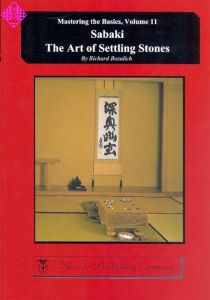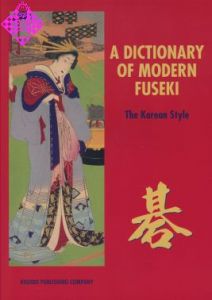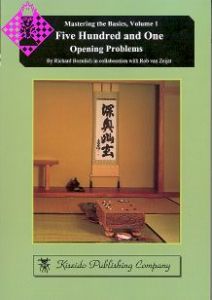Article Number
LGHARBT
Basic Techniques of Go
169 pages, paperback, Kiseido, 3. edition 1992, first edition 1969
Discontinued
| EAN | 9784906574025 |
|---|---|
| Weight | 210 g |
| Manufacturer | Kiseido |
| Width | 11.1 cm |
| Height | 15.6 cm |
| Medium | Book |
| Year of Publication | 1992 |
| Author | Isamu HaruyamaYoshiaki Nagahara |
| Language | English |
| Edition | 3 |
| ISBN-10 | 4871870022 |
| ISBN-13 | 9784906574025 |
| Year of First Edition | 1969 |
| Pages | 169 |
| Binding | paperback |
| Name | Kiseido Publishing Company |
|---|
Chapter One
001 Principles of Even-Game Openings
001 a) Opening Moves
004 b) Corner Enclosures
007 c) Approach Moves
010 d) Proper Timing of Enclosures, Approach Moves, and Extensions
015 How to Play Handicap Go
Chapter Two
016 The Nine-Stone Handicap and the Attach-and-Extend Joseki
Chapter Three
027 Six-Stone Handicap Opening Strategy
027 a) White's Capping Strategy
034 b) Invading the Sides
Chapter Four
040 Four-Stone Handicap and the One-Space Jump Joseki
050 The One-Space Jump in Four-Stone Handicap Openings
050 a) The Pincer
063 b) Double Approach Moves
070 c) Double Pincer
073 d) The Attachment
077 e) Capping
082 f) The Invasion
Chapter Five
084 A Survey of Tesuji
084 Tesuji Problems
120 Answer to the Tesuji Problems
Chapter Six
130 The Endgame
130 a) Counting the Size of a Territory
133 b) Sente Endgame
136 c) Counting the Size of an Endgame Play
143 d) Endgame Tesujis
156 e) Endgame Problems
165 Appendix
Preface to the Third Edition
This book is written for players who know the rules and the most elementary tactics and wish to reach expert strength. It assumes that the reader has read one of the Ishi Press beginner books such as Introduction to Go, The Magic of Go, or Go for Beginners.
The text of this edition has been completely rewritten, although the diagrams (and content) are nearly the same as those in the second edition. The only major change has been the up-dating of an old joseki by Rob van Zeijst, which appears in the appendix. In addition, the order of the chaphas been changed: what is now Chapter Five, Tesuji, was Chapter One in the previous two editions. In addition, a number of errors have been corrected.
In the first two editions, Japanese terms were used throughout the book. In this edition, I have eliminated almost all these terms, retaining only the most essential ones such as atari, sente, gote, etc. These terms are defined in the glossary at the beginning. I believe this change will make this book more accessible to all beginning players.
The three main areas of go are covered in this book: the opening, the middle game, and the endgame. The emphasis in the opening sections is on handicap go. Since beginners plays most of their games with handicaps, they will have ample opportunity to adopt the strategies described in this book It is hoped that these strategies will help them win most of their high-handicap games.
Richard Bozulich April, 1992
001 Principles of Even-Game Openings
001 a) Opening Moves
004 b) Corner Enclosures
007 c) Approach Moves
010 d) Proper Timing of Enclosures, Approach Moves, and Extensions
015 How to Play Handicap Go
Chapter Two
016 The Nine-Stone Handicap and the Attach-and-Extend Joseki
Chapter Three
027 Six-Stone Handicap Opening Strategy
027 a) White's Capping Strategy
034 b) Invading the Sides
Chapter Four
040 Four-Stone Handicap and the One-Space Jump Joseki
050 The One-Space Jump in Four-Stone Handicap Openings
050 a) The Pincer
063 b) Double Approach Moves
070 c) Double Pincer
073 d) The Attachment
077 e) Capping
082 f) The Invasion
Chapter Five
084 A Survey of Tesuji
084 Tesuji Problems
120 Answer to the Tesuji Problems
Chapter Six
130 The Endgame
130 a) Counting the Size of a Territory
133 b) Sente Endgame
136 c) Counting the Size of an Endgame Play
143 d) Endgame Tesujis
156 e) Endgame Problems
165 Appendix
Preface to the Third Edition
This book is written for players who know the rules and the most elementary tactics and wish to reach expert strength. It assumes that the reader has read one of the Ishi Press beginner books such as Introduction to Go, The Magic of Go, or Go for Beginners.
The text of this edition has been completely rewritten, although the diagrams (and content) are nearly the same as those in the second edition. The only major change has been the up-dating of an old joseki by Rob van Zeijst, which appears in the appendix. In addition, the order of the chaphas been changed: what is now Chapter Five, Tesuji, was Chapter One in the previous two editions. In addition, a number of errors have been corrected.
In the first two editions, Japanese terms were used throughout the book. In this edition, I have eliminated almost all these terms, retaining only the most essential ones such as atari, sente, gote, etc. These terms are defined in the glossary at the beginning. I believe this change will make this book more accessible to all beginning players.
The three main areas of go are covered in this book: the opening, the middle game, and the endgame. The emphasis in the opening sections is on handicap go. Since beginners plays most of their games with handicaps, they will have ample opportunity to adopt the strategies described in this book It is hoped that these strategies will help them win most of their high-handicap games.
Richard Bozulich April, 1992
More from Kiseido
-
 Essential Go Proverbs€59.00
Essential Go Proverbs€59.00 -
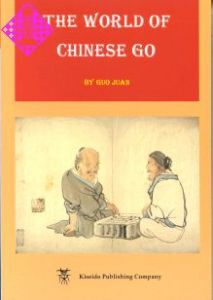 The World of Chinese Go€16.50
The World of Chinese Go€16.50 -
 Joseki Revolution€24.95
Joseki Revolution€24.95 - More from Kiseido

